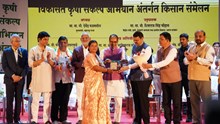
Bihar’s love for khaini is so popular that even former chief minister Lalu Prasad could often be seen chewing it in public. Finding favour with the political establishment in some ways prevented this sun-dried/fermented kind of tobacco from being subject to the state's ban on other addictive substances like alcohol, gutka, and pan masala.
A user traditionally prepares khaini by placing coarsely chopped tobacco leaves and slaked lime in the palm and thoroughly rubbing the mixture with the thumb. Also, it is offered commercially in sachets that have liquorice and spices added to make it more enticing.
In Bihar, Vaishali and Alipur are the main production centres of khaini, while Muzaffarpur, Darbhanga, and Sitamarhi also contribute. Due to the favourable environment in the area, the Sarairanjan and Ujiarpur blocks in the Samastipur district are well known for their high-quality saraisa khaini. Far larger than the markets for cigarettes or bidi, the product has a niche market.
Despite having a high nicotine level comparable to that of cigarettes or gutka, Khaini is the tobacco product with the lowest tax rate in the state. While tobacco leaves are subject to a 5% GST reverse charge, other tobacco products are subject to a 28% GST. The political influence and connections of the Koeri-Mahtos, a backward caste with significant investments in tobacco production and related enterprises in Bihar, are mostly to blame for the passive acceptance of khaini and double standards in taxation.
The government at the same time does not compensate tobacco farmers in the event of crop loss or promote any scheme on this front to keep its image transparent. Therefore, the farmers are left to fend for themselves, come rain or shine. Yet, many continue to cultivate tobacco due to the high-profit margins a good crop year can offer.
In Bihar, Tobacco produced is mostly made into khaini. In 2014, when Jitan Ram Manjhi was the chief minister, the tax on tobacco products barring khaini and bidi doubled from 30% to 60%.
Shambhu Mahto, a farmer claimed, “There is no benefit in tobacco cultivation when we consider the uncertainty and risk. We cultivate it only when we manage to make more money out of wheat/rice crop,” who prepared khaini from his crop on two bighas of land in Sarairanjan block last time. He spent Rs 80,000 on cultivation and turned raw leaves into khaini, hoping for a better price. But what traders had offered him was just Rs 10,000 to 15,000 more than his expenses.
Responding to this, an official on condition of anonymity said, “How can the government support its cultivation when tobacco causes cancer to millions of people? There should be an alternative to tobacco cultivation.”
People of Bihar term khaini as buddhivardhak churna (a brain booster mixture). However, no amount of whitewashing or endorsements by celebrities and politicians can enhance its reputation. It is high time farmers detached from tobacco cultivation and introduced ethically right crops.

















